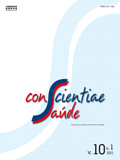Balance and plantar arch in classical ballet
DOI:
https://doi.org/10.5585/conscientiaesaude/2011/v10n1/2550Keywords:
Balance, Cavus, Dance.Abstract
Introduction: The ability to remain standing, and develop movement is due to the presence of balance and base maintenance support provided by the feet. Objective: To assess the body balance and type of the plantar arch of practitioners of classical ballet. Methods: A sample of 15 subjects were divided in two groups: basic and intermediate. Checking the balance held by a pressure platform and arch classification done by tracing ôplantigraphycö. Results: No statistically significant difference (p = 0.173) between the speed of oscillation of the groups. Predominated in the overall sample cavus feet with greater weight-bearing forefoot bilaterally. Conclusion: There was prevalence of pes cavus, but it was not possible to establish a correlation between balance and plantar arch type for the sample studied. Also no detectable difference in the rate of oscillation between the basic and intermediate level.Downloads
Downloads
Published
How to Cite
Issue
Section
License
Copyright (c) 2011 ConScientiae Saúde

This work is licensed under a Creative Commons Attribution-NonCommercial-ShareAlike 4.0 International License.
Autores que publicam nesta revista concordam com os seguintes termos:
O(s) autor(es) autoriza(m) a publicação do texto na revista;
O(s) autor(es) garantem que a contribuição é original e inédita e que não está em processo de avaliação em outra(s) revista(s);
A revista não se responsabiliza pelas opiniões, idéias e conceitos emitidos nos textos, por serem de inteira responsabilidade de seu(s) autor(es);
É reservado aos editores o direito de proceder a ajustes textuais e de adequação às normas da publicação;
Autores mantém os direitos autorais e concedem à revista o direito de primeira publicação, com o trabalho simultaneamente licenciado sob uma Licença Creative Commons Atribuição-NãoComercial-CompartilhaIgual 4.0 Internacional;
Autores têm permissão e são estimulados a publicar e distribuir seu trabalho online (ex.: em repositórios institucionais ou na sua página pessoal) já que isso pode gerar alterações produtivas, bem como aumentar o impacto e a citação do trabalho publicado;
Em virtude de aparecerem nesta revista de acesso público, os artigos são de uso gratuito, com atribuições próprias, em aplicações educacionais e não-comerciais.



